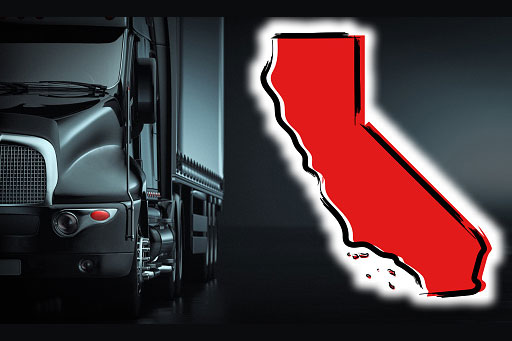‘Too much, too soon,’ truckers say of tough new California air quality rules on heavy trucks
California likes to think of itself as being in the forefront of most environmental regulations. But California’s decision to set rules that will essentially ban new diesel trucks in the Golden State by 2035 is being seen by the trucking industry as moving too fast.
Essentially what the trucking industry is telling California is it is moving too fast, too soon. The regulations, it is saying, are moving faster than the technology.
The Biden administration earlier had allowed California to set rules phasing out diesel trucks. This has caused an uproar from regional and national trucking groups as well as the Owner-Operator Independent Driver Association (OOIDA) on the expected impact of the rules. The electric truck mandate was approved by the California Air Resources Board in 2020 but needed a waiver from the EPA. because it is stricter than federal standards.
American Trucking Associations (ATA) President and CEO Chris Spear blasted the Biden administration’s decision to allow California to move forward with the damaging and unrealistic emissions rule that he says will harm the industry nationwide by causing a “patchwork” of separate state regulations.
Spear said the California Air Resources Board’s (CARB) adoption of its “Advanced Clean Fleets” regulation was premature and economically not viable. If upheld, Spear said the decision to force motor carriers to purchase zero-emission vehicles ignores the fact that these trucks are early-stage technologies and the infrastructure to support them does not exist.
“Today, an unelected Board in California voted to force trucking companies to buy zero-emission trucks,” Spear said in a statement on April 28.
Fleets are just beginning to understand what it takes to successfully operate these trucks, Spear added. But what they have learned so far is they are significantly more expensive, charging and refueling infrastructure is nonexistent and zero emission vehicles are not necessarily a one-for-one replacement—meaning more trucks will be needed on California roads to move the same amount of freight.
“California is setting unrealistic targets and unachievable timelines that will undoubtedly lead to higher prices for the goods and services delivered to the state and fewer options for consumers,” Spear said.
As it becomes clear that California’s rhetoric is not being matched by technology, Spear said the trucking industry hopes the California Air Resources Board will reverse course and allow trucking companies the freedom to choose the clean technologies that work best for their operations.
“ATA-member companies work tirelessly to deliver the nation’s freight while deploying the cleanest technologies available, Spear added. “Over the past 35 years, those efforts have produced a 98% reduction in truck emissions. We continue to say, ‘Yes’ to advancing cleaner technologies, but achievable targets and realistic timelines matter.”
Spear also criticized the EPA for allowing California’s waiver for its so-called ‘advanced clean trucks’ rule. Basically, he said, the EPA is handing over the keys as a national regulator to an unelected state regulator, Spear said.
“This isn’t the United States of California, and in order to mollify a never satisfied fringe environmental lobby by allowing the state to proceed with these technologically infeasible rules on unworkable and unrealistic timelines, the EPA is sowing the ground for a future supply chain crisis,” Spear added.
Spear said as the nation learned during the pandemic, the nation’s supply chain is fragile. Even small disruptions can cause huge problems nationally and globally. He said that could occur again if clean trucks became the norm without the available technology to support them nationally.
Besides the lack of technology to support mass-market EVs, the Washington Post reported on the effect of increased sales of EVs are having on production of bauxite, a key mineral on EV use. And where will those key minerals will come from? EVs typically require six times the mineral input by weight compared with fossil-fuel-burning counterparts.
Powering an 80,000-pound tractor trailer is likely to cause a new worldwide search for precious metals, including bauxite, nickel, lithium and manganese, needed to build and power them. Who knows what the unintended consequences of securing these minerals are?
Spear noted that the trucking industry has worked “tirelessly” with the EPA on aggressive, achievable timelines for reducing emissions. Over the past 35 years, he said, that collaboration has produced a 98% reduction in truck emissions.
The EPA’s waiver authorized California to enforce what it calls its “Advanced Clean Trucks” rule. That requires 75% of Class 4-8 truck sales to be zero-emission vehicles by 2035.
Last November, the U.S. joined an international agreement to shift all truck sales to zero-emissions by 2040. The EPA followed with a December rule toughening heavy-duty truck emissions standards, beginning with model year 2027 vehicles.
California is the first known entity in the world to require zero-emissions trucks. That move has brought together disparate factions of the oft-divided trucking world.
The Owner-Operator Independent Drivers Association (OOIDA), which often clashes with ATA over issues such as driver pay and safety, took the unusual step of agreeing with ATA’s position on the California rule.
“Vehicle reliability and affordability are top priorities for OOIDA members,” OOIDA President and CEO Todd Spencer said in a statement. “We have yet to see proof that electric [trucks] are a realistic option for most trucking businesses considering the price tag and lack of charging infrastructure. The bottom line is that the technology they’re trying to mandate does not yet exist.”
Under California rules, diesel and gasoline-powered drayage trucks must retire after 18 years to guarantee that they meet a zero-emission requirement by 2035.
In addition, under the California proposals issued by that state’s Air Resources Board, half of all new trucks purchased by state and local governments would be zero-emission in 2024, increasing to 100% by 2027.













